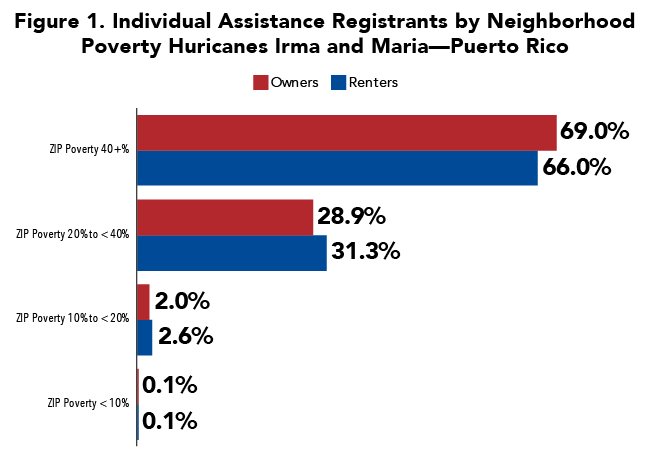Deep Poverty Complicates Recovery Efforts for Puerto Rico
Nov 28, 2017
Within the span of two weeks in September, Hurricanes Irma and Maria brought massive devastation to Puerto Rico. Much of the island still remains without power and tens of thousands of Puerto Ricans have left for the mainland. Making matters worse, the island has been in economic recession for over a decade, the median household income in Puerto Rico is barely $20,000 per year, and the government struggles with a debt crisis that has resulted in austerity.
To better understand the impact of the hurricanes on homeowners and renters in Puerto Rico, NLIHC analyzed recently released FEMA data about registrations for assistance from the Individuals and Households Program (IHP) for both Hurricanes Irma and Maria. IHP provides approved registrants with assistance for rent, home repair (for homeowners), or other serious disaster-related needs, like medical care, transportation, storage, or essential household items. The data provide a ZIP code-level summary of the number and ownership status of registrants, extent of damage, and the dollar amounts approved for assistance.
Unlike NLIHC’s previous analyses of Hurricane Harvey registrants in Texas and Hurricane Irma registrants in Florida, which showed a disproportionate share of renters over homeowners requesting assistance, the data from Puerto Rico show homeowners and renters are requesting assistance proportionate to their populations. Registrants in Puerto Rico, however, generally have far more limited financial resources than their counterparts in Texas and Florida. There is an acute need to allocate sufficient federal resources to ensure an equitable recovery for all Puerto Ricans.
Over 811,000 Puerto Ricans have registered for assistance through IHP. Seventy percent of registrants are homeowners and 30% are renters (table 1). To date, 120,860 owner and 64,005 renter registrants have been approved for assistance, representing 21.3% and 26.3% of owner and renter registrants, respectively. The remaining registrants either have decisions pending or have been deemed ineligible.
|
Puerto Rico Registrants |
(All Households in IA-Eligible Area) |
|||||
|
Owners |
Renters |
Total |
Owners |
Renters |
Total |
|
|
568,163 |
243,597 |
811,760 |
857,710 |
386,492 |
1,244,202 |
|
|
% of Total |
70.0% |
30.0% |
100.0% |
68.9% |
31.1% |
100.0% |
Figure 1 below shows the distribution of renter and owner registrants across neighborhoods categorized by their poverty rates. Registrants in Puerto Rico differ from their counterparts in Texas and Florida in two ways. First, and most strikingly, 68% of Puerto Rican registrants live in neighborhoods where the poverty rate exceeds 40%. Only 2% of registrants in Florida and 1.9% of registrants in Texas lived in similar neighborhoods. Second, in Puerto Rico owner and renter registrants alike reside in high-poverty neighborhoods with poverty rates greater than 20%.

FEMA’s IHP data do not include registrant incomes, but we can estimate the income distribution of registrants by assuming their incomes reflect the income distribution of their ZIP codes (table 2). Registrants in Puerto are far more likely have low incomes than registrants in Texas and Florida. Fifty-two percent of owner registrants and 77% of renter registrants in Puerto Rico have annual incomes less than $25,000. By comparison, 16% of owner registrants and 37% of renter registrants in Texas have incomes below $25,000, and 20% of owner registrants and 40% of renter registrants in Florida earn less than $25,000. Furthermore, 21% of owner registrants and 46% of renter registrants in Puerto Rico have annual incomes of less than $10,000. In short, a substantial number of Puerto Rican registrants, particularly renters, live in deep poverty.
|
Income of Registrants |
Disaster Area |
||||
|
Owners |
Renters |
Owners |
Renters |
||
|
< $25,000 |
52.0% |
77.0% |
< $25,000 |
51.0% |
78.0% |
|
$25,000 to $49,999 |
27.0% |
16.0% |
$25,000 to $49,999 |
27.0% |
16.0% |
|
$50,000 to $74,999 |
12.0% |
4.0% |
$50,000 to $74,999 |
12.0% |
3.0% |
|
$75,000 to $99,999 |
5.0% |
1.0% |
$75,000 to $99,999 |
5.0% |
1.0% |
|
$100,000+ |
5.0% |
1.0% |
$100,000+ |
5.0% |
1.0% |
According to the Centers for Disease Control (CDC), households with limited financial resources are at greater risk for being disproportionately impacted by disasters. With such low incomes, registrants in Puerto Rico will continue to face acute challenges in recovering from Hurricanes Irma and Maria. It is critical that the federal government does not repeat past mistakes by failing to assist the lowest income households. Recovery efforts in Puerto Rico must prioritize the needs of registrants who were living in deep poverty prior to the storms.
Congress and the Administration will need to provide sufficient resources and oversight to ensure an equitable recovery. In particular, Community Development Block Grants for Disaster Recovery (CDBG-DR) will be critical to ensuring an equitable housing recovery for the lowest income households. It remains unclear, however, whether Congress and the administration are committed to sufficiently funding this program and providing the oversight needed to meet the housing recovery needs of Puerto Rico.